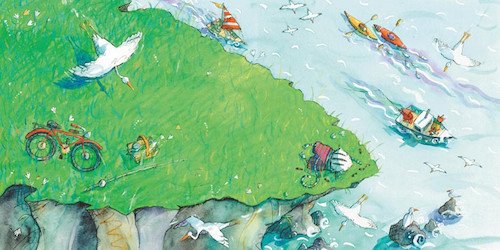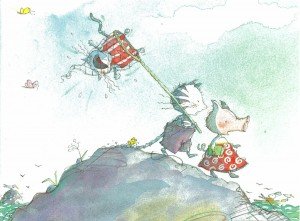My cat has a few skills. She is a master of food procurement, especially the hunting and gathering of fish-flavoured snacks. The white expanse of her impressive belly absorbs the heat of the sun, keeping the house cool in summer. The vibrational pitch of her purrs make fly swatters and wasp repellants entirely unnessary.
Nevertheless, in spite of her talents (and pretty face), my cat cannot fly-a fate shared by Caramba, the star of Marie-Louise Gay’s Caramba and Henry, the second in her series of picture books about a plump, flightless cat. In Caramba’s world, all cats can fly. They are also very colourfully attired, but then…every creature in Marie-Louise Gay’s impressive list of publications, feline or otherwise, sports a crayola-hued pair of trousers, or some other equally bright fashion accessory. And that’s just the clothing. The story is important, and so are the characterizations, but first…always first…is the glorious application of paint to paper. Flying cats are just the bonus.
But back to the story. Difference is never easy, and it is particularly vexing to Caramba to learn that his very own little brother is showing signs that he too is capable of flight, an ability shared by everyone except Caramba. On top of that, like all older siblings everywhere, Caramba is charged with watching over Henry, ensuring his safety and his amusement. But Henry is not easily amused. He screams all the time, he doesn’t like his older brother’s cheese omeletes, and don’t even ask what he does to Caramba’s jar of colourful caterpillars. After an awkward and foliage-tangling attempt at taking Henry for a walk, Caramba ties him to a string and flies him like a kite. Both Caramba and his friend Portia think this is a great idea, until Henry wriggles free, disappearing into the green sky. All the sibling protectiveness eroded by jealousy (and more than a little exhaustion) comes to the fore as Caramba frantically searches for his airborn brother. Suffice to say, Caramba’s resourcefulness, and a generous dose of brotherly love, saves the day.
In Caramba and Henry, the graceful fluidity of line and tone is stunning, like open tubes of paint dropped into a pail of water. As always, the details are delicious, like Caramba’s beloved fuzzy caterpillars, Henry’s red-striped onesie, and the charm and critter-infused marshes that serve as background for most of the book. And yet, in spite of the visual complexity, Gay somehow manages to retain an almost languid sensibility in her illustrations. It’s a tonic for the eyes, and certainly she is my go-to illustrator when the world turns drab and gray. As I said in a previous post about this French-Canadian artist, “Marie-Louise Gay is the cure for dull.”
Marie-Louise Gay has been lauded across this country and throughout the world for her gifts as an illustrator and storyteller. She is a two-time recipient of the Governor General’s Gold Medal, and is in possession of an awesome website, Marie-Louise Gay’s World. The former art  director has taught illustration at the Universite du Quebec a Montreal, and continues to give readings, workshops and talks in schools and libraries and at conferences across Canada, Europe, Mexico and the United States. Interestingly, on a recent trip to Sweden, Marie-Louise Gay was the only Canadian children’s book author and illustrator I could find on the shelves. This should come as no surprise, as her humourous and wonderfully vibrant watercolours share a similarity to Pija Lindenbaum, one of Scandinavia’s most popular storytellers. Ms Gay lives in Montreal with her family.
director has taught illustration at the Universite du Quebec a Montreal, and continues to give readings, workshops and talks in schools and libraries and at conferences across Canada, Europe, Mexico and the United States. Interestingly, on a recent trip to Sweden, Marie-Louise Gay was the only Canadian children’s book author and illustrator I could find on the shelves. This should come as no surprise, as her humourous and wonderfully vibrant watercolours share a similarity to Pija Lindenbaum, one of Scandinavia’s most popular storytellers. Ms Gay lives in Montreal with her family.
Caramba and Henry by Marie-Louise Gay, published by Groundwood Books, 2011.



